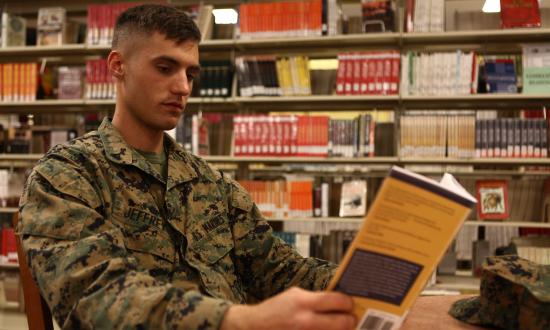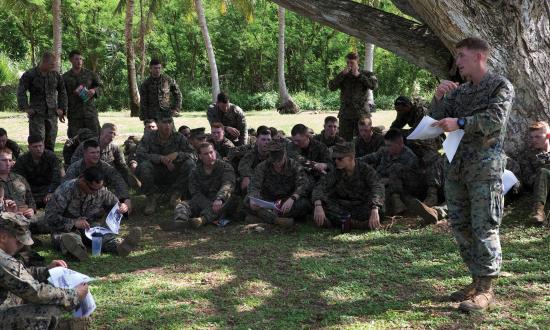Prior to my own foray into joint professional military education (JPME), I stumbled across Commander Graham Scarbro’s January 2019 Proceedings article, “Rethink the ‘J’ in JPME.”1 Scarbro contends that JPME places too great a focus on preparing naval officers to solve joint problems before they are adequately familiar with their own service’s capabilities. He laments, for example, that his first substantive briefing on the Tomahawk land-attack missile came 14 years into his career as a carrier aviator.
Scarbro correctly diagnoses a problem to which I also have fallen victim: starting professional education with JPME. After completing my first JPME course (Strategy and War) as a seventh-year lieutenant, I could quote Clausewitz and Sun Tzu, muse about multinational coalitions during World War II, or discuss the tacticization of strategy during Vietnam. If, however, you asked me about the composition of the carrier strike group to which I was to be detailed, I would have needed to do a little research.
A naval officer’s first PME course should be focused on the history, customs, and traditions of the naval profession, the Navy’s capabilities across all domains of war, and the importance of sea power to national strategic objectives. This common foundation would produce several valuable results: Officers from different communities would be better equipped to integrate their forces in combat. Midgrade officers serving on a joint staff would be more prepared to serve as ambassadors for the Navy, rather than simply promoting their warfare platforms. Perhaps most important, such a course would foster pride and an esprit de corps among an officer cadre that better understands the importance of its role in the Navy’s wider mission and the importance of the Navy to the national mission.
Scarbro proposes that the Navy push JPME to the right in an officer’s career timeline, making it an O-6 requirement, and create a “Navy Professional Military Education (NPME)” for intermediate-level officers. In essence, though, the NPME concept already exists. It is called primary PME, and it is available to any officer with a common access card reader. The Naval War College has been offering self-starting junior officers a distance-learning naval education for more than a decade.2 So why aren’t more officers taking advantage of this opportunity?
What is Primary PME?
The Chairman of the Joint Chiefs of Staff (CJCS) policy on officer PME delineates policies and procedures for the PME continuum. Most naval officers are familiar with the intermediate-level course, JPME Phase 1, which is required for unrestricted line officers to assume O-5 command at sea. But JPME is not the first course described by the CJCS curriculum. Junior officers in paygrades O-1 through O-3 are owed their own course, primary PME, “focused on specialized skills and tactical knowledge in Service-specific constructs.”3
The Naval War College hosts the Navy’s current iteration of primary PME on the Navy eLearning website. The course is self-paced, computer-based training, consisting of 70 hours of narrated slides and periodic multiple-choice learning assessments. Topics include Navy culture and governance, theory of war, the composite warfare commander construct, domains of force employment, and technology in the maritime domain.
I have sampled several of the course modules. Though not exactly riveting, the material is thorough and clearly required significant time and effort to compile. An officer with the time and mental focus to absorb nearly three full days of glorified PowerPoint lectures would be much closer to achieving the course’s objective: “a broad and common understanding of our Navy.”4
But is this version of primary PME the best we can do? I would be curious to see the completion rates for the course, but based on a “very scientific” survey conducted by asking around among my fellow junior officers, few seem to know the course exists.
I cannot recall a single time in my career when a senior officer or Navy program advertised or encouraged primary PME. Neither can I find any incentive for clicking through primary PME’s seemingly endless slides beyond my own edification. Most important, I do not understand why primary PME is still conducted with computer-based training when the Navy already has recognized the ineffectiveness of that method.5
A New Primary PME
The first step toward increasing participation in primary PME is providing an incentive. A high-performing first-tour naval officer is a busy individual. Between earning warfare qualifications, learning how to be a division officer, and keeping up with command collateral duties, few should be expected to pursue a self-guided primary PME course with no reward beyond an eLearning certificate.
An easy solution would be to add an additional qualification designation (AQD) for primary PME completion. An AQD would be available on an officer service record for both statutory and administrative boards, enabling the Navy to reward an educational pursuit with career advancement. The AQD should not be a requirement for selection—primary PME should not be one more thing a JO has to do—but its presence would send the message that a candidate is willing to invest in professional development and has obtained a solid foundation in naval operations. Documenting primary PME progress and completion on officer fitness reports would be another way to incentivize the program while also meeting the goal of identifying and rewarding commitment to continuous learning.
The next step is to spread the word. Primary PME could be introduced and encouraged through commissioning sources, officer training commands, the Division Officer Leadership Course, and command professional development briefs. The message will get around when fitness report rankings and promotion and screen board statistics begin to demonstrate that primary PME is valued.
The most important step for revitalizing primary PME is also the most challenging. Clicking through endless slides and answering multiple-choice questions on minutiae read 30 seconds ago is neither worthy of an AQD nor the ideal way to infuse the officer cadre with professional pride and knowledge. Delivery of primary PME needs to change.
The primary PME curriculum should foster purpose-driven conversations between officers and their superiors and among officers of different warfare areas. A formal, in-residence, Navy PME school, taught by the finest officers of each designator, would be fantastic but likely would never get off the ground.
A simpler solution would be a personnel qualification standard (PQS). A primary PME PQS could be maintained by the Naval War College for issuance to interested officers. The PQS would list the topics and measures of performance for desired subject areas. Line items would require “sign-offs” from other officers with appropriate backgrounds and qualifications. The War College could host the PQS electronically, allowing “instructors” to acknowledge PQS completion digitally.
For example, topics such as Navy governance or theory of war could require a sign-off from an O-5 JPME graduate, perhaps a skipper or an executive officer. Line items across the various warfare domains would require sign-offs from officers with the corresponding warfare and/or platform qualifications. Navy culture might best be taught by senior enlisted leaders. The concept would provide primary PME aspirants a roadmap for interacting with leaders at multiple levels from all corners of the fleet.
For a PQS to work, junior officers should not be left to seek out and collect signatures. Leaders must take steps to provide opportunities for primary PME progression. Command professional development divisions could help coordinate and foster small group meetings, reaching out to other units in the area for opportunities to exchange ideas and experience. The Naval War College could facilitate virtual primary PME sessions. Command triads could lead discussions with their wardrooms.
Not every signature would be a record of rigorous discourse; some discussions will be better than others. But almost any conversation between two qualified officers of different backgrounds is likely to leave both better informed than equivalent time spent on computer-based training. The goal of primary PME is to help officers get to know the Navy. The best way to do that is to give us a system and the tools to get to know each other.
Not Just Another Qual
I can already feel the ire of my fellow junior officers, wary of adding to the constant creep of qualifications and requirements. While sympathetic to that concern, I am more alarmed that momentum appears to be building toward pushing JPME leftward on an officer’s career path.6
Professional military education can and should be the foundation of officer development. But the best way to prepare junior and midgrade officers to serve in joint roles is not teaching them how to craft high-level military strategy and policy. The Navy needs officers capable of advocating for the conventions and capabilities of their own force. Rethink primary PME, and give our officers the opportunity to introduce each other to the many facets of the fleet.
1. LCDR Graham Scarbro, USN, “Rethink the ‘J’ in JPME,” U.S. Naval Institute Proceedings 145, no. 1 (January 2019).
2. Naval War College Public Affairs, “NWC Launches Updated Primary PME Courses on NKO,” navy.mil, 2 October 2009.
3. CJCSI 1800.01F, “Officer Professional Military Education Policy,” appendix A, section 6, 15 May 2020.
4. Navy eLearning, “Primary Professional Military Education (Officer)."
5. Chief of Naval Personnel, “Navy Ends Online GMT Requirements,” navy.mil, 27 March 2017.
6. Ben Werner, “Navy, Marine Corps Want to Update Service’s Professional Military Education,” USNI News, 18 November 2019.






